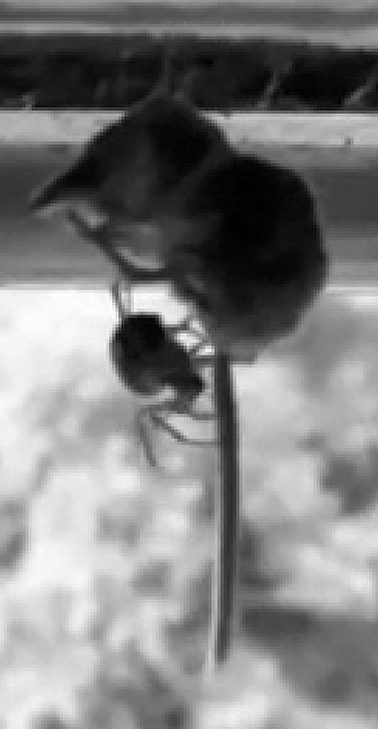
Female Steatoda nobilis 
Scientists at University of Galway have published the first record of a noble false widow spider feeding on a pygmy shrew, a species of tiny mammal protected in Ireland.
The new study, recently published in the international journal ‘Ecosphere’, demonstrates further the potentially negative impact of the invasive and venomous noble false widow spider on native species.
It is the first time a member of this family of spiders, called ‘Theridiidae,’ has been recorded preying on a shrew in Ireland or in Britain. It is also the first time for any species of false widow spider to prey on shrews anywhere in the world.
The extraordinary discovery was made by Dawn Sturgess at a home in Chichester, West Sussex, southern England when a small mammal was found entangled in a spider’s web constructed on the outside of a bedroom window. The ensnared creature was later identified by the lengths of tooth rows as a pygmy shrew ‘Sorex minutus’.
The shrew was still alive, but the spider’s highly potent neurotoxic venom was evidently taking effect as the shrew became increasingly incapacitated. The spider was observed hoisting the shrew upwards into the rafters where it wrapped it in silk and fed off its meal for three days.
In Ireland the pygmy shrew is protected under the Wildlife Act (1976) and Wildlife (Amendment) Act 2000. In the UK, the species is protected under the Wildlife and Countryside Act, 1981.
This is the third case in recent years of a protected vertebrate species falling prey to the noble false widow in Ireland or the UK, and this represents the eighth species of vertebrate known to fall prey to members of the false widow genus Steatoda. The noble false widow now appears to be a regular vertebrate-eating spider.
In a previous study published in the journal Food Webs in 2021, researchers at University of Galway’s Venom Lab provided video evidence of a false widow spider lifting a significantly larger gecko off the ground with exceptional ease using its silk threads as a pulley system. It appears that the noble false widow spider used an identical method to hoist the shrew higher up the web.
Over the past seven years, the research team, led by Dr Michel Dugon at University of Galway’s Ryan Institute, have been studying a wide range of characteristics specific to the species including its venom, symptoms associated with their venomous bite, ecology and behaviour.
Dr Michel Dugon, Head of the Venom Systems Lab, Ryan Institute, University of Galway and lead author of the study, said: “This observation demonstrates further that the noble false widow is perfectly adapted to take down large prey, combining potent venom, extremely strong silk, and complex hunting behaviour.”
Dr John Dunbar, Irish Research Council Post-Doctoral fellow, Venom Systems Lab, Ryan Institute, University of Galway, and senior author of the study said: “The noble false widow is a very intriguing spider, and we have much to learn about it still. We are very grateful to the members of the public who share their observations with us. This allows us to understand better how this invasive species may impact us and our environment.”
The scientists at University of Galway are encouraging members of the public to email them at falsewidow@universityofgalway.ie to report sightings of the noble false widow spider.


